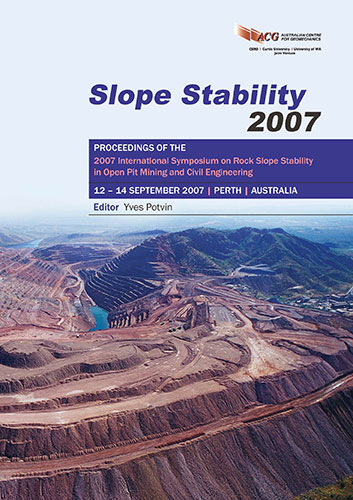Rock Slope Stability Research

|
Authors: Read, JRL |
DOI https://doi.org/10.36487/ACG_repo/708_Read
Cite As:
Read, JRL 2007, 'Rock Slope Stability Research', in Y Potvin (ed.), Slope Stability 2007: Proceedings of the 2007 International Symposium on Rock Slope Stability in Open Pit Mining and Civil Engineering, Australian Centre for Geomechanics, Perth, pp. 355-359, https://doi.org/10.36487/ACG_repo/708_Read
Abstract:
The methods we use to describe the anisotropic strength of closely jointed rock masses are highly subjective and experiential. Consequently, there is a need to construct an ‘equivalent material’ that honours the strength of the intact rock and joint fabric within the rock bridges that may occur along a candidate failure surface in a closely jointed rock mass. We then need to be able to use this model to simulate the brittle fracture that can and does propagate across the joint fabric within the rock bridges as the rock mass deforms. It has been found that the Bonded Particle Method utilised by the Itasca PFC numerical modelling codes may be able to provide such a material model. Known as the Synthetic Rock Mass (SRM) model, the model represents the intact rock in the rock bridges with an assemblage of bonded particles and the joints by a sliding joint model that allows associated particles to slide through, rather than over, one another and so represent joints that slide and open in the normal way. In 3-D block caving simulations SRM rock bridge fracture has been found to be widespread. From a rock slope stability point of view the model has the potential to provide a means of developing a strength envelope that does not rely on either Mohr Coulomb or Hoek-Brown criteria. Similarly, the inverse of providing Hoek-Brown parameters and calibrating the Hoek- Brown strength envelope should also be possible. A rock mass characterisation program with numerical and empirical comparisons involving SRM test samples calibrated with intact rock and joint data coming from different mine sites has therefore been developed to test the concept in conjunction with studies to utilise the model in PFC and continuum/discontinuum codes for slope stability analysis purposes.
References:
Bieniawski, Z.T. (1976) Rock mass classification in Rock Engineering Applications. In Exploration for Rock
Engineering: Proc. of the Symposium, Johannesburg, 1, pp. 97-106. A.A. Balkema, Rotterdam.
Bieniawski, Z.T. (1989) Engineering Rock Mass Classifications. John Wiley & Sons, 251 p.
Cundall, P.A. (2007) PFC modelling of large slopes in brittle, jointed rock. Confidential LOP Project Report,
unpublished, 10 p.
Deere, D.U. and Deere, D.W. (1988) The Rock Quality Designation (RQD) Index in Practice. Rock Classification
Systems for Engineering Purposes, ASTM STP 984, pp. 91-101.
Deere, D.U., Hendron A.J., Patton, F.D. and Cording, E.J. (1967) Design of Surface and Near-Surface Construction in
Rock. SME, 1967, Failure & Breakage of Rock, pp. 237-302.
Hoek, E. (1983) Strength of Jointed Rock Masses. 23rd Rankine Lecture. Geotechnique, XXXIII, pp. 185-223.
Hoek, E., Kaiser, P.K. and Bawden, W.F. (1995) Support of Underground Excavations in hard Rock. Mining Research
Directorate & Universities Research Incentive Fund, Canada, 215p.
Hoek, E., Carranza-Torres, C. and Corkum, B. (2002) Hoek-Brown Failure Criterion - 2002 Edition. Proc. North
American Rock Mech. Soc., Toronto, July 2002, 7 p.
Laubscher, D.H. (1990) A geomechanics classification system for the rating of rock mass in mine design. J. S. Afr. Inst.
Metall., 90 (10), pp. 267-273.
Laubscher, D.H. and Jakubec, J. (2001) The MRMR rock mass classification for jointed rock masses. Underground
Mining Methods. Engineering Fundamentals and International Case Studies, W.A. Hustrulid and R.L. Bullock
(editors), Society of Mining Engineers, AIME: New York, pp. 474-481.
Pierce, M. Cundall, P. and Potyondy, D. (2007) A synthetic rock mass model for jointed rock. 1st Canada-U.S. Rock
Mechanics Symposium, Vancouver, B.C., May 27-31, 2007, pp. 341-349.
Potyondy, D.O. and Cundall, P.A. (2004) A bonded particle model for rock. Int. J. Rock Mechanics & Mining Sciences,
41, pp. 1329-1364.
Read, J.R.L (2007) Predicting the behaviour and failure of large rock slopes. 1st Canada-U.S. Rock Mechanics
Symposium, Vancouver, B.C., May 27-31, 2007, pp. 1237-1243.
Read, J.R.L. and Ogden, A.N. (2006) Developing New Approaches to Rock Slope Stability Analyses. Int. Symposium
on the Stability of Rock Slopes in Open Pit Mining and Civil Engineering Situations, Cape Town, South Africa.
SAIMM, Symposium Series S44, pp. 3-10.
Rock Slope Stability
Slope Stability 2007, Perth, Australia 359
© Copyright 2025, Australian Centre for Geomechanics (ACG), The University of Western Australia. All rights reserved.
View copyright/legal information
Please direct any queries or error reports to repository-acg@uwa.edu.au
View copyright/legal information
Please direct any queries or error reports to repository-acg@uwa.edu.au